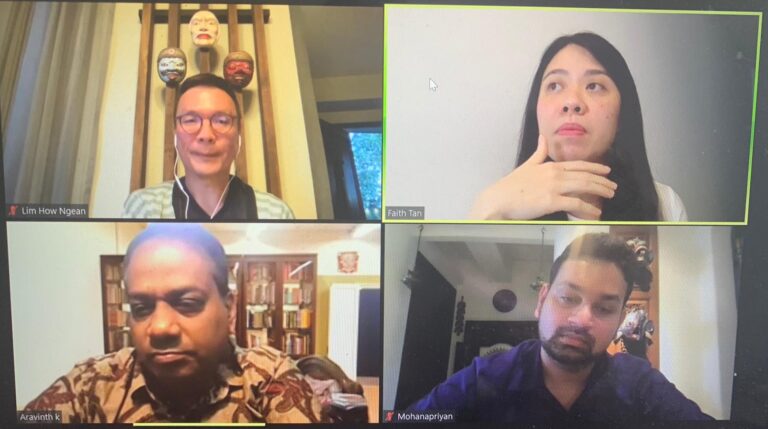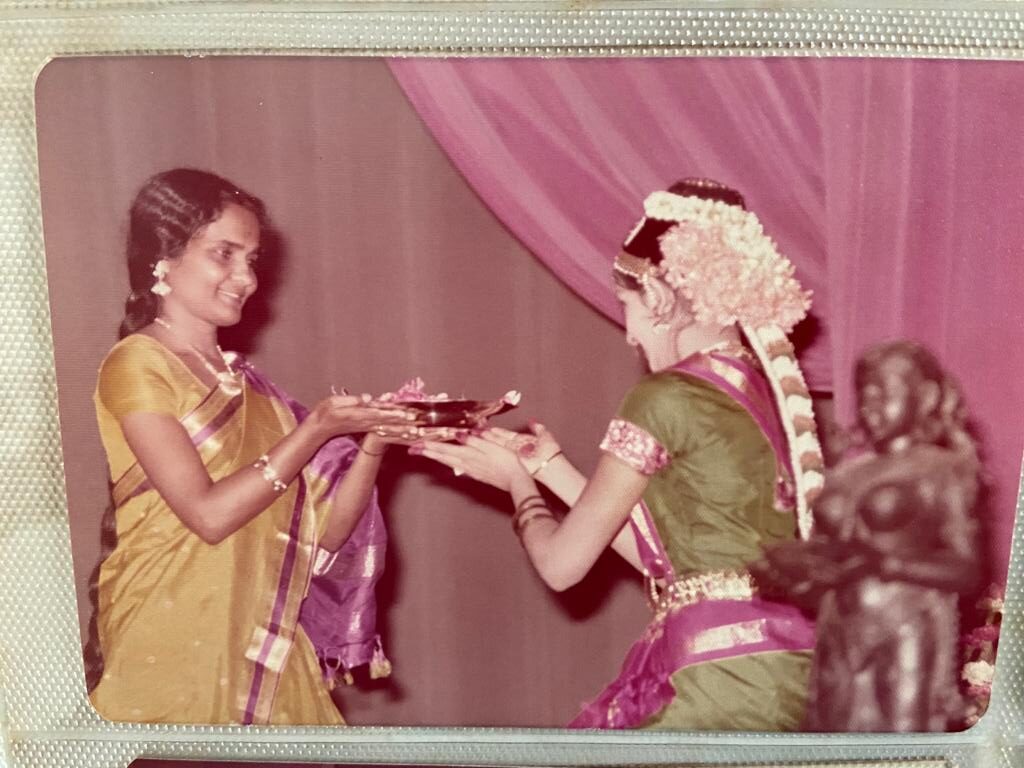Dramaturgy in dance making: Critical Collaboration in Motion

By Soumee De “The dramaturg is the third eye for the choreographer.” The SPOTLIGHT series for 2021 kicked off with an insightful session on DRAMATRUGY in dance-making by Lim How Ngean, Dramaturg and founder of Asian Dramaturgs’ Network (ADN), followed by a conversation with a panelists Faith Tan, Head of Dance and Theatre at Esplanade – Theatres on the Bay; Aravinth Kumarasamy, Artistic and Managing Director of Apsaras Arts and Mohanapriyan Thavarajah, Resident choreographer and principal dancer, Apsaras Arts. On Sunday 31st January the SPOTLIGHT series for 2021 kicked off with an insightful session on DRAMATRUGY in dance-making by Lim How Ngean, Dramaturg and founder of Asian Dramaturgs’ Network (ADN), followed by a conversation with a panelists Faith Tan, Head of Dance and Theatre at Esplanade – Theatres on the Bay; Aravinth Kumarasamy, Artistic and Managing Director of Apsaras Arts and Mohanapriyan Thavarajah, Resident choreographer and principal dancer, Apsaras Arts. Lim How Ngean, has been actively involved in the performing arts for 30 years, practicing in Malaysia and Singapore. He has been dramaturging dance since 2009 for various institutions and individual choreographers. In his talk, he introduced the different aspects of performing arts and how dance needs to fit into the bigger picture that affects the spectatorship. In a critical examination of the performance flow, he explained the cause and effect through his experiences of working with acclaimed Singaporean choreographers Daniel Kok, Joavien Ng, Kuik Swee Boon and Ming Poon, Thailand’s Pichet Klunchun, and, Phnom Penh-based Amrita Performing Arts. In particular, he raised the better question (along with examples) on the impact of the ride of the audience throughout the performance flow. In the second half of the webinar, Lim How Ngean was joined by Faith Tan, Aravinth Kumarasamy and Mohanapriyan Thavarajah, where they exchanged stories from their past works like Anjaneyam on what the dramaturg can do and cannot do; creative tension and collaboration between the roles of dramaturg and artistic director and choreographer. Faith Tan emphasized the importance of working with dramaturg in a dance production and she sees this as not a nice-to-have but a necessary-to-have role in the success of a performing arts production. In conclusion we walked away with a beautiful learning from Pitchet Klunchun: “Dramaturg is the watcher who observes the choreographer and the work under creation phase, then gives feedback from different perspectives…. comments from dramaturg is important because it can help the choreographer get back to focusing on the right track. The dramaturg is the third eye for the choreographer.”
Interview with Roshni Pillay Kesavan

– a personal odyssey through cultural education & where Bharatanatyam is headed in Singapore By Vidhya Nair VN: Tell us about yourself – your roots and growing up years? RPK: I come from a Ceylon-Tamil family with deep roots in Malaysia-Singapore for several generations. My father’s family is entirely from Seremban. (Dr V K Pillay, a well-known orthopaedic, community leader and philanthrope). He came to medical school in Singapore and met my mother whose entire family was here. My parents initially lived in Seremban but due to the separation of Malaysia-Singapore and my father’s medical training, they settled permanently in Singapore. Some of our family have since migrated to other countries. I am a third generation Singaporean- and my entire exposure to Bharatanatyam and all the training I received was entirely in Singapore. I consider myself a product of the unique cultural scene here; always comfortable in my pottu and pavada sattai yet I was educated at an English convent (CHIJ Victoria Street). I feel it’s a reflection of this country, multiculturalism has enabled those of us from a minority culture to feel rooted in our identity yet able to be part of a larger milieu. My mother and my aunts had learned Carnatic violin as children and my father really appreciated Carnatic music. Growing up with three older brothers, we all went for piano classes but anything pertaining to Indian culture was for the daughter not the sons. Perhaps this is a peculiarity of Ceylon-Tamil families. I always accompanied my parents for Indian cultural events but not my brothers. I think the first they ever attended was my Arangetram in 1975! I had an older maternal cousin, Jayalakshmi (Jaime akka) who was a dancer, a student of Mrs Bhaskar. Growing up I saw many pictures of her in dance poses. She was my first image of a dancer within the family. Another was a paternal cousin, Shymala from Malaysia, who went to Kalakshetra to earn a post-grad diploma in the days when Neila Mami was teaching there. I have a memory of visiting my cousin and watching Mami take class there. Shymala would tell me “She is the gentlest teacher here.” My cousin would share the rigour of murumandi jumps – a series of 100 sets. If you stopped at 90, you would be asked to repeat all over again! Imagine the gruelling training! That cousin really inspired me. The first dance kutcheris I watched in Chennai were with her. Tamil was really a language I didn’t speak fluently. I had learnt Malay in school so my exposure to it was really exchanges with my grandmothers who lived with us on occasion and I never really spoke Srilankan-Tamil either. I did have a Tamil vadhiyar come home for tuition as a 3rd language, but my parents felt fluency in Malay outweighed Tamil as it was a more useful regional language . Immersion in Indian culture was not 24/7. So time spent with my dance teacher, Madhavi Muthu and veena teachers, Muthumeenakshi Mami and Padmavathy Anandagopalan (sister of Lalgudi Jayaraman) at SIFAS was key to my cultural development. They were strict and deeply entrenched in the culture. We visited India like tourists. It’s only as I have grown older, I have absorbed the culture more. The encouragement of my parents and the Bharatanatyam friends I had in my teens (the Avadhani & Natarajan sisters) kept my interest going. I never acknowledged myself as a “Dancer” or saw myself as one growing up. It’s unusual I think but that’s been my experience. You learn for the art’s sake; it doesn’t define your personality. In fact, even in my husband’s family the exposure to Tamil and Indian culture was minimal. There was more appreciation for Western performing arts like ballet and classical western music and English was the only language spoken at home. So, my performing Bharatanatyam was like a unique, new experience for them. VN: How did your dance training begin? RPK: My dance training began formally at SIFAS, first with the Narasimhacharis in 1970-72 in Kuchipudi. I didn’t even know it as that then. It was just learning of items not a style as such. Then it was Madhavi Muthu with formal structured Bharatanatyam. I recall fainting in my first class, as a young skinny child, the rigour of the exercises was quite overwhelming. I had to be revived with Milo! The routine was Veena and Bharatanatyam. My father was a fan of Veena S Balachander, Chitty Babu whose recitals he would play on his record player. I was also privileged to meet these artistes when they came to Singapore . I was also learning Carnatic Vocal from Anandagopalan Maama( my Veena teacher’s spouse). My days were filled with classes. Back then, it was twice a week for 2 hours for each subject, so lots of hours are spent on the road and in class. During school holidays, there were even more classes. The time after my A levels was especially special as I spent a lot of time with Padmavathy Mami. I had so many lunches cooked by Padmavathy Maami, when SIFAS was located at the large bungalow at Bournemouth Road. I still remember her delicious podis (not a part of the Ceylon Tamil culinary repertoire)! Back then, time was unlimited but over the years as the school grew and more students joined, the pressure to allocate a fixed time for students normalised. Today, we see SIFAS as an institution but then it was a modified Gurukulam. As there were less students, there were more opportunities to perform. The Society committee members were also very paternal-maternal offering so much support and encouragement. During my arangetram rehearsals Aunty Kokila Rajan, Dr Rajan, Mr I S Menon would come by to watch. It was a wonderful environment to have cultural immersion. I enjoyed the nurturing environment at SIFAS. We also watched amazing performances. I recall watching Lakshmi Viswanathan who was a young dancer then with her sister Charumathi Ramachandran singing. It was so beautiful. There were